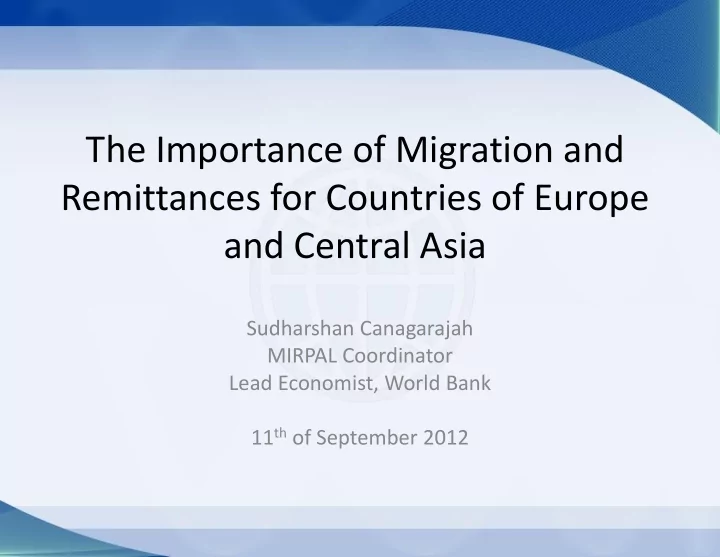

The Importance of Migration and Remittances for Countries of Europe and Central Asia Sudharshan Canagarajah MIRPAL Coordinator Lead Economist, World Bank 11 th of September 2012
Messages Migration and remittances continue to be a key pillar of development strategy of many countries in Europe and Central Asia Crisis has impacted new migration flows but, in general, migrants are not returning, that is, migration stock is still rising Remittances proved to be resilient to economic shocks in host countries for those countries which have permanent migration, but effects were more pronounced in countries which rely on seasonal migration
Migration and Remittance Trends
Remittances projected to grow in medium-term 2012 f 2013 f 2014 f $ billion 2010 2011e Developing countries 332 372 399 430 467 East Asia and Pacific 95 107 115 125 135 Europe and Central Asia 37 41 45 49 55 Latin America and Caribbean 57 62 66 72 77 Middle-East and North Africa 40 42 45 47 50 South Asia 82 97 104 113 122 Sub-Saharan Africa 21 22 24 25 27 Growth rate (%) Developing countries 7.7% 12.1% 7.2% 7.8% 8.4% East Asia and Pacific 10.6% 12.6% 7.3% 8.0% 8.7% Europe and Central Asia 0.3% 12.6% 8.8% 10.1% 11.4% Latin America and Caribbean 0.9% 7.7% 7.6% 7.9% 8.2% Middle-East and North Africa 19.5% 5.7% 5.1% 5.3% 5.5% South Asia 9.5% 18.2% 7.4% 7.9% 8.4% Sub-Saharan Africa 1.9% 8.5% 6.3% 6.8% 7.4%
CIS countries have large (and increasing) migrant populations so remittance flows will remain significant for many years Figure: Migration stock as percent of total population Source: World Bank’s Migration and Remittance Factbook 2011
The Global Economic Crisis Did Not Create Significant Disruption of Migration Flows as Many Feared Data on migration inflows and outflows is limited in many countries Overall, there has been little evidence of return migration caused by the economic downturn in host countries One reason is that incomes and employment opportunities back home are not that high Second, migrants are unwilling to return home fearing that they may not be able to re-enter Financial incentives for return migration (Spain, Japan, Gulf countries) are not working
Remittances Represent a Significant Source of External Financing Remittances as share of GDP, 2010 (%) 35% 30% 25% 20% 15% 10% 5% 0%
Remittances vis- à -vis Other External Inflows to Europe and Central Asia $ billions 200 180 160 140 120 100 80 60 40 20 0 1991 1993 1995 1997 1999 2001 2003 2005 2007 2009 2011e Source : Migration and Development Brief 17
Remittances Have Been Growing Over the Last Decade in Most Sub-regions of Europe and Central Asia; the Global Crises Disrupted this Trend but Recovery is on the Way Remittance inflows (in USD million) 35 000 30 000 25 000 Russia 20 000 Other CIS EU-10 15 000 Balkans 10 000 Turkey 5 000 - 2000 2001 2002 2003 2004 2005 2006 2007 2008 2009 2010 2011e Source: World Bank
In CIS Countries, the Effects of the 2008-09 Crisis Were Most Visible in Tajikistan and Moldova: Both Countries Have High Seasonal Migration to Russia Remittance inflows (in USD million) 6 000 Armenia 5 000 Azerbaijan 4 000 Belarus Georgia 3 000 Kazakhstan Kyrgyz R 2 000 Moldova 1 000 Tajikistan Ukraine - 2000 2001 2002 2003 2004 2005 2006 2007 2008 2009 2010 2011e
Remittances from Russia to CIS Countries are Highly Correlated with Oil Price Movements $/barrel $ billio ns $ billions $/barrel 140 8 120 100 6 Crude oil price (right scale) 80 4 60 40 Remittance outflows from 2 Russia (left scale) 20 0 0 2004 Q4 2005 Q4 2006 Q4 2007 Q4 2008 Q4 2009 Q4 2010 Q4 2011 Q4 Source : IMF Balance of Payments and Development Prospects Group, World Bank.
Remittances Remain Resilient During Downturns in Host Countries Remittances are sent by the stock (cumulated flows) of migrants Remittances are a small part of migrants’ incomes that can be cushioned against income shocks by migrants Duration of migration may increase in response to tighter border controls Two opposing factors determine where savings are kept: migrants have higher confidence in the host country (“safe haven”) or in their home country (“home - bias”) Fiscal stimulus packages (in public infrastructure) helps migrants in construction and services sectors
Crisis, Remittance and Economic Growth Decreasing employment opportunities in host countries, lower remittances, and lower export demand put pressure on balance of payments in countries which rely on remittances In turn, lower income and consumption reduce the GDP growth potential Unfinished structural reforms and weak fiscal position at the beginning of the global economic crisis made the situation worse As a result, CIS countries with large remittance/GDP ratios recorded a slowdown in GDP growth in 2009/10 Medium-term outlook is uncertain, recovery in EU is weak but growth in Russia is projected to remain robust
Growth is to Some Extent Correlated With Changes in Remittance Inflows 70,0 100,0 60,0 80,0 50,0 60,0 40,0 40,0 30,0 20,0 20,0 0,0 10,0 0,0 -20,0 Remittances (change in %) 2007 GDP (change in %) 2007 Remittances (change in %) 2008 GDP (change in %) 2008 40,0 35,0 30,0 30,0 20,0 25,0 10,0 20,0 0,0 15,0 -10,0 10,0 -20,0 5,0 -30,0 0,0 -40,0 -5,0 Remittances (change in %) 2009 GDP (change in %) 2009 Remittances (change in %) 2010 GDP (change in %) 2010
Remittance have multiple effects on economy: monetary, fiscal, and social Remittances affect exchange rate, financial sector, fiscal revenue Migration has implications on labor market, poverty as well as social implications Understanding the linkages between remittances and other economic variables are important for policy makers: In making economic projections In defining policies that maximize the impact on economic development
Data and other resources are available at: www.worldbank.org/eca/migration www.worldbank.org/prospects/migrationandremittances http://peoplemove.worldbank.org www.mirpal.org
Recommend
More recommend